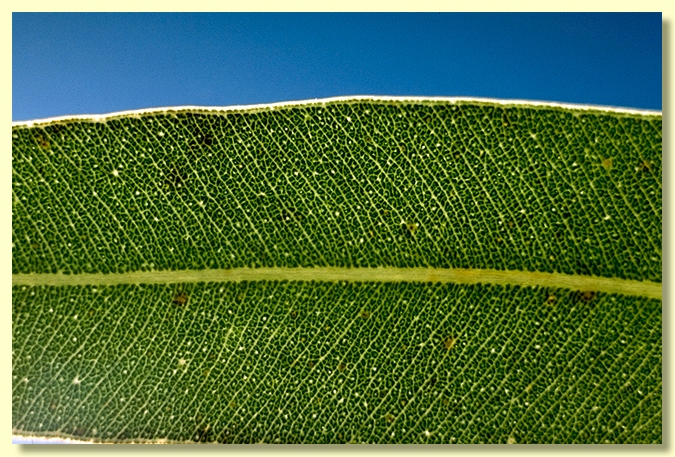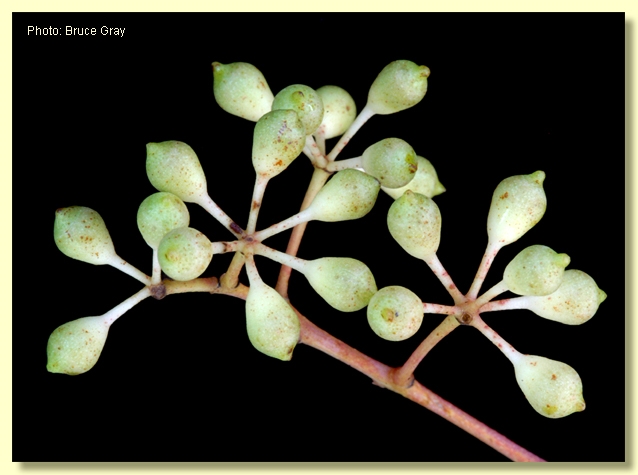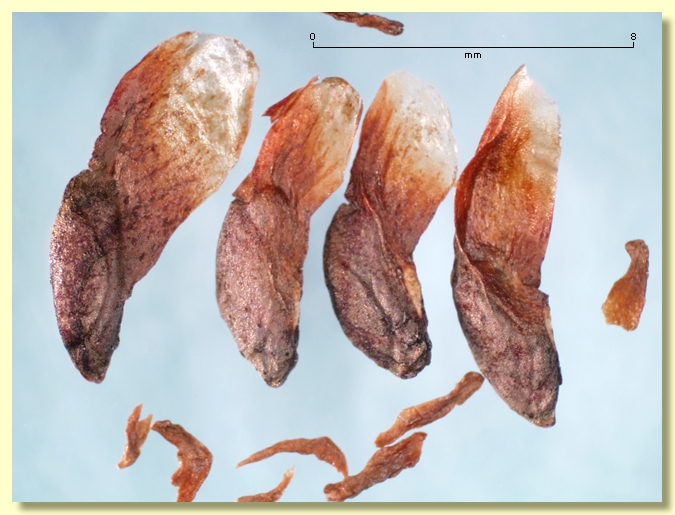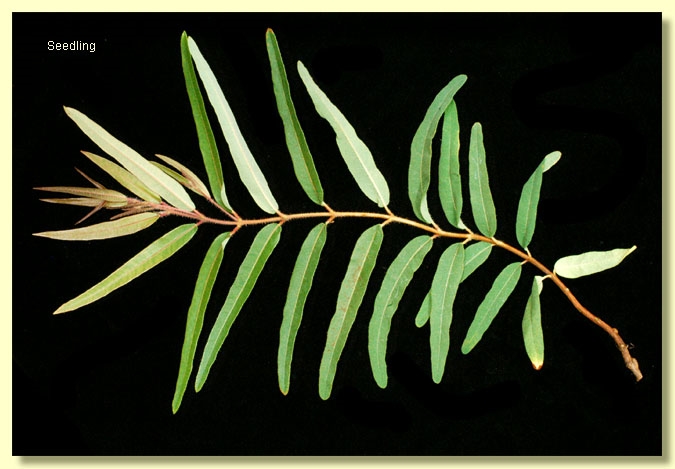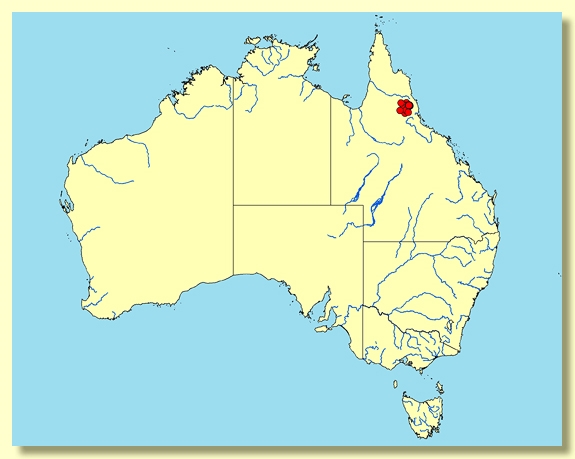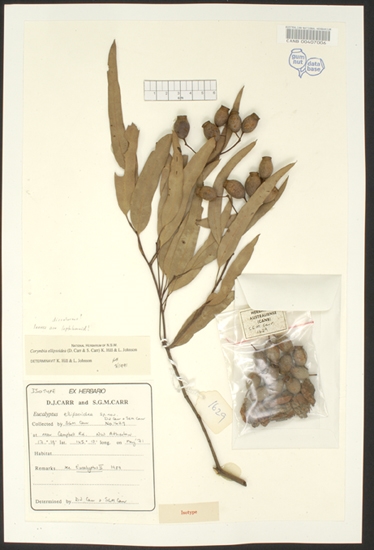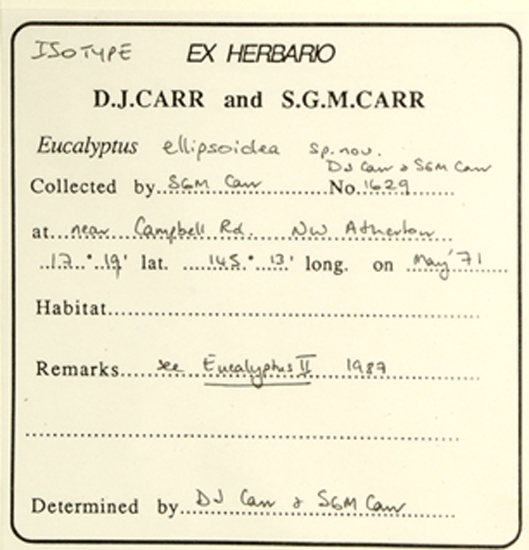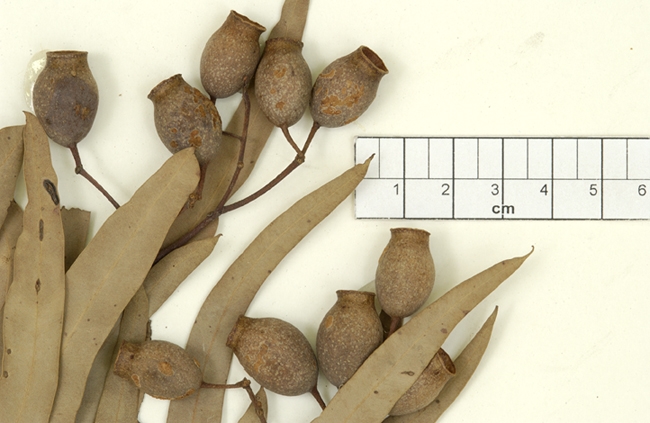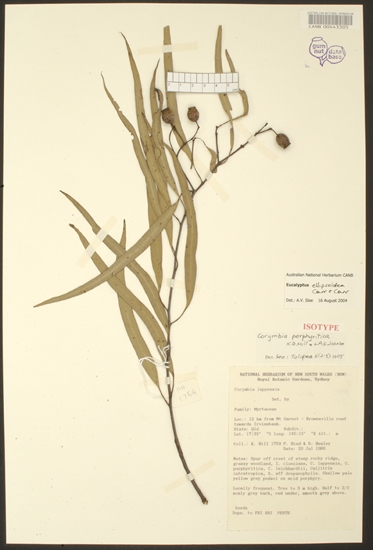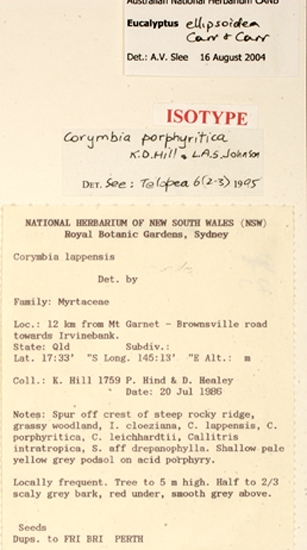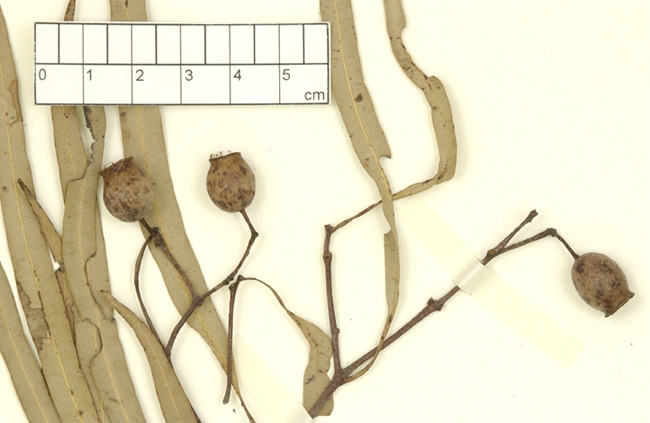Corymbia | Rufaria
Euclid - Online edition
Corymbia ellipsoidea
Corymbia ellipsoidea (D.J.Carr & S.G.M.Carr) K.D.Hill & L.A.S.Johnson, Telopea 6: 306 (1995).
Tree to 15 m tall. Forming a lignotuber.
Bark rough, persistent on trunk and often also on the larger limbs, on older trunks thick, fissured to tessellated grey over reddish to orange, on branches grey to reddish flaky to scaly, ultimately smooth cream to pinkish or grey.
Branchlets smooth (glabrous); elongated oil bodies occur in the pith.
Juvenile growth (coppice or field seedlings to 50 cm): not seen.
Adult leaves alternate, petioles 1.1–2.8 cm long; narrowly lanceolate to lanceolate, (7)9–17.5(24) cm long, 0.7–2.3(2.7) cm wide, base tapering to petiole, margin entire, apex pointed, concolorous, dull, green, smooth, side-veins at greater than 45° to midrib (penniveined), reticulation dense to very dense, intramarginal vein not visible (confluent with margin) or visible but very close to margin (variable between leaves on the same specimen), oil glands sparse and island or not visible.
Inflorescence terminal compound, peduncles slender, rounded, (0.4)0.8–2.1 cm long, buds 7 per umbel, pedicels slender, (0.3)0.5–1.1 cm long. Mature buds obovoid or pyriform, 0.7–0.8 cm long, 0.4–0.5 cm wide, smooth and shiny, scar absent (both opercula shed together at flowering), operculum shallowly rounded or flattened, apiculate or not, stamens inflexed, all fertile, anthers oblong, dorsifixed, versatile, dehiscing by longitudinal slits, style as long as the floral cavity, straight, stigma blunt to mop-like, locules 4, the placentae each with ca 4 or 5 vertical ovule rows or the rows indistinct. Flowers creamy white.
Fruit pedicellate (pedicels 0.3–1 cm long), ± barrel-shaped or tending to urn-shaped in outline, narrowed above to a distinct neck with the thin rim flared widely or rarely erect, 1.2–1.9 cm long, 0.9–1.4 cm wide, longer than wide, surface smooth, disc descending vertically or sometimes obliquely, valves usually 3, sometimes 4, enclosed.
Seeds brown, 6–8 mm long, ellipsoidal with terminal wing, hilum ventral.
Cultivated seedlings (measured at ca node 10): cotyledons large, reniform; stems rounded in cross-section, sparsely setose for basal lower 4 nodes then glabrous; leaves always shortly petiolate, opposite for at least 9 nodes, lower leaves elliptical then becoming oblong, 5–6.5 cm long, 0.5–1 cm wide, base ± tapering to petiole, apex pointed or rounded and apiculate, green, very sparsely setose but only to leaf-pair ca 3, glabrous thereafter.
Flowering has beeen recorded in January and February.
Small bloodwood tree endemic to Queensland and restricted in distribution to the ranges immediately to the west and south-west of Atherton, from Watsonville to Irvinebank, Mount Garnet, Stannary Hills, Almaden and Herberton, and extending south-west to the Newcastle Range. It prefers sandy soils, often skeletal, on granite, sandstone or porphyry hills and ridges. Corymbia ellipsoidea has tessellated to fissured or flaky rough bark on trunk and often larger limbs, grey, flaking to reveal reddish underbark, a green dull-leaved crown of concolorous leaves in which the intramarginal vein is often not visible or, if visible, scarcely separate from the leaf margin. Buds in the terminal inflorescences are ± pear-shaped and shiny whilst the fruit are ± barrel-shaped in outline with a distinct neck.
C. ellipsoidea differs from the more widespread C. erythrophloia in seedling leaf width and in habitat preference. C. ellipsoidea has seedling leaves (measured at node ca 10) to 0.5–1 cm wide, whilst C. erythrophloia has seedling leaves 2–4 cm wide; C. ellipsoidea prefers skeletal sandy soils whilst C. erythrophloia is found on red and black clays over basalt in undulating country. The fruit of C. ellipsoidea tend to be more elliptical in outline than those of C. erythrophloia. Both species have reddish tones to the newly exposed underbark.
Other partly or fully rough-barked bloodwood species likely to be confused with C. ellipsoidea are: C. pocillum, which occurs in the western Newcastle and Gregory Ranges and south-east of Normanton and has much more globular fruit slightly smaller than those of C. ellipsoidea, though the dimensions overlap; C. hylandii, C. stockeri, C. intermedia, C. polycarpa, C. serendipita and C. trachyphloia all differ from C. ellipsoidea in having adult leaves that are darker above and distinctly paler on the underside.
Brooker and Kleinig (1994) included E. ellipsoidea and a third species, E. pocillum, in Eucalyptus erythrophloia. There is no doubt that these three species are closely related and at times difficult to tell apart.
Hill & Johnson (1995) also described another species, C. porphyritica from the same region as C. ellipsoidea and occupies a similar habitat and with a remarkably similar description. The differences between the two species are not clear to the authors of EUCLID and C. porphyritica is included in synonymy.
MORE ABOUT CORYMBIA
MORE ABOUT RED BLOODWOODS
Corymbia ellipsoidea: Latin ellipsis, referring to the geometric plane figure (ellipse), with the ending -oidea, indicating resemblance to the geometric solid (ellipsoid) that results from rotating an ellipse about one of its two axes. The fruit in this species is ± barrel-shaped, i.e. more or less ellipsoid.



